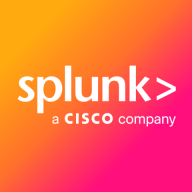

Splunk Observability Cloud and Elastic Observability compete in the observability and monitoring category. Splunk Observability has the upper hand in comprehensive monitoring capabilities, while Elastic excels in search and log analytics.
Features: Splunk Observability Cloud provides comprehensive monitoring, real-time alerting, and custom dashboards for application performance monitoring. It integrates well with various cloud services, offering robust API support. Users value its cohesive dashboard view for monitoring both cloud and on-premises systems. Elastic Observability stands out for its powerful text search and log analytics. It allows detailed incident response and root cause analysis and offers flexible integration with various environments, alongside a customizable interface.
Room for Improvement: Splunk Observability Cloud could enhance its pricing structure and ease of use, particularly for custom metrics and data ingestion. Users suggest more streamlined integration with enterprise offerings and improvements in query language and machine learning features. Elastic Observability is recommended to enhance its APM capabilities, simplify deployment processes, and improve predictive analytics. Users also seek more proactive monitoring capabilities and better customization options for dashboards.
Ease of Deployment and Customer Service: Splunk and Elastic offer deployment flexibility across on-premises, cloud, and hybrid environments, yet users find Elastic has a steeper learning curve, notably for beginners. Splunk deployments are praised for stability and adaptability. The customer support for Splunk varies, with responsive service but room for improvement in rapid problem-solving and technical assistance. Elastic's support is deemed adequate, though users often rely on internal teams for troubleshooting.
Pricing and ROI: Splunk Observability Cloud is reported as expensive, especially as licensing costs scale with data volume. However, users see positive ROI through its monitoring capabilities and reduced downtime. Elastic Observability offers a competitive pricing model, appreciated for affordability by large-scale users and those leveraging its open-source components. Users recognize its cost-effectiveness for handling extensive data and monitoring needs.
Using Splunk has saved my organization about 30% of our budget compared to using multiple different monitoring products.
Anyone working in front-end management should recognize the market price to see the true value of end-user monitoring.
They often require multiple questions, with five or six emails to get a response.
Support from Splunk is not very helpful because Splunk doesn't have a dedicated APM; they only have one APM engineer in Korea.
They did respond to us, but they did not explicitly inform us about the feature's absence.
Elastic Observability seems to have a good scale-out capability.
What is not scalable for us is not on Elastic's side.
We've used the solution across more than 250 people, including engineers.
I would rate its scalability a nine out of ten.
The issue is mainly about pricing because if they want to monitor more, it costs money.
It is very stable, and I would rate it ten out of ten based on my interaction with it.
Elastic Observability is really stable.
I would rate its stability a nine out of ten.
We rarely have problems accessing the dashboard or the page.
Unlike NetScout or regular agents for APM, RUM has many problems during the POC phase because customer environments vary widely.
For instance, if you have many error logs and want to create a rule with a custom query, such as triggering an alert for five errors in the last hour, all you need to do is open the AI bot, type this question, and it generates an Elastic query for you to use in your alert rules.
It lacked some capabilities when handling on-prem devices, like network observability, package flow analysis, and device performance data on the infrastructure side.
One example is the inability to monitor very old databases with the newest version.
There is room for improvement in the alerting system, which is complicated and has less documentation available.
Improvements in dashboard configuration, customization, and artificial intelligence functionalities are desired.
Customers sometimes need to create specific dashboards, particularly for applicative metrics such as Java and process terms.
The license is reasonably priced, however, the VMs where we host the solution are extremely expensive, making the overall cost in the public cloud high.
Elastic Observability is cost-efficient and provides all features in the enterprise license without asset-based licensing.
Observability is actually cheaper compared to logs because you're not indexing huge blobs of text and trying to parse those.
Splunk is a bit expensive since it charges based on the indexing rate of data.
It appears to be expensive compared to competitors.
Splunk is a little expensive, however, it is in line with the current market pricing.
The most valuable feature is the integrated platform that allows customers to start from observability and expand into other areas like security, EDR solutions, etc.
the most valued feature of Elastic is its log analytics capabilities.
All the features that we use, such as monitoring, dashboarding, reporting, the possibility of alerting, and the way we index the data, are important.
Splunk provides advanced notifications of roadblocks in the application, which helps us to improve and avoid impacts during high-volume days.
For troubleshooting, we can detect problems in seconds, which is particularly helpful for digital teams.
It offers unified visibility for logs, metrics, and traces.


Elastic Observability is primarily used for monitoring login events, application performance, and infrastructure, supporting significant data volumes through features like log aggregation, centralized logging, and system metric analysis.
Elastic Observability employs Elastic APM for performance and latency analysis, significantly aiding business KPIs and technical stability. It is popular among users for system and server monitoring, capacity planning, cyber security, and managing data pipelines. With the integration of Kibana, it offers robust visualization, reporting, and incident response capabilities through rapid log searches while supporting machine learning and hybrid cloud environments.
What are Elastic Observability's key features?Companies in technology, finance, healthcare, and other industries implement Elastic Observability for tailored monitoring solutions. They find its integration with existing systems useful for maintaining operation efficiency and security, particularly valuing the visualization capabilities through Kibana to monitor KPIs and improve incident response times.
Splunk Observability Cloud offers sophisticated log searching, data integration, and customizable dashboards. With rapid deployment and ease of use, this cloud service enhances monitoring capabilities across IT infrastructures for comprehensive end-to-end visibility.
Focused on enhancing performance management and security, Splunk Observability Cloud supports environments through its data visualization and analysis tools. Users appreciate its robust application performance monitoring and troubleshooting insights. However, improvements in integrations, interface customization, scalability, and automation are needed. Users find value in its capabilities for infrastructure and network monitoring, as well as log analytics, albeit cost considerations and better documentation are desired. Enhancements in real-time monitoring and network protection are also noted as areas for development.
What are the key features?In industries, Splunk Observability Cloud is implemented for security management by analyzing logs from detection systems, offering real-time alerts and troubleshooting for cloud-native applications. It is leveraged for machine data analysis, improving infrastructure visibility and supporting network and application performance management efforts.
We monitor all Application Performance Monitoring (APM) and Observability reviews to prevent fraudulent reviews and keep review quality high. We do not post reviews by company employees or direct competitors. We validate each review for authenticity via cross-reference with LinkedIn, and personal follow-up with the reviewer when necessary.